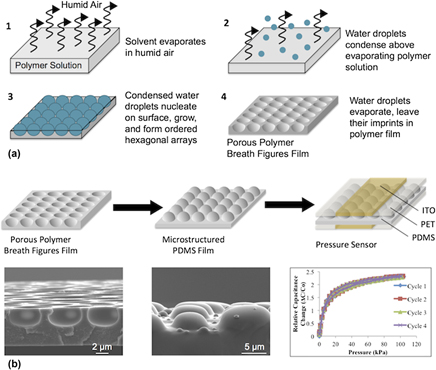Crossref Citations
This article has been cited by the following publications. This list is generated based on data provided by
Crossref.
An, Boxing
Ma, Ying
Li, Wenbo
Su, Meng
Li, Fengyu
and
Song, Yanlin
2016.
Three-dimensional multi-recognition flexible wearable sensor via graphene aerogel printing.
Chemical Communications,
Vol. 52,
Issue. 73,
p.
10948.
Kang, Subin
Lee, Jaehong
Lee, Sanggeun
Kim, SeulGee
Kim, Jae‐Kang
Algadi, Hassan
Al‐Sayari, Saleh
Kim, Dae‐Eun
Kim, DaeEun
and
Lee, Taeyoon
2016.
Highly Sensitive Pressure Sensor Based on Bioinspired Porous Structure for Real‐Time Tactile Sensing.
Advanced Electronic Materials,
Vol. 2,
Issue. 12,
Zhang, Yuan
Hu, Yougen
Zhao, Tao
Zhu, Pengli
Sun, Rong
and
Wong, Chingping
2017.
Highly sensitive flexible pressure sensor based on microstructured PDMS for wearable electronics application.
p.
853.
Gong, Jianliang
Xu, Bingang
and
Tao, Xiaoming
2017.
Breath Figure Micromolding Approach for Regulating the Microstructures of Polymeric Films for Triboelectric Nanogenerators.
ACS Applied Materials & Interfaces,
Vol. 9,
Issue. 5,
p.
4988.
Fernandes, Jayer
and
Jiang, Hongrui
2017.
Three-Axis Capacitive Touch-Force Sensor for Clinical Breast Examination Simulators.
IEEE Sensors Journal,
Vol. 17,
Issue. 22,
p.
7231.
Chhetry, Ashok
Yoon, Hyosang
and
Park, Jae Yeong
2017.
A flexible and highly sensitive capacitive pressure sensor based on conductive fibers with a microporous dielectric for wearable electronics.
Journal of Materials Chemistry C,
Vol. 5,
Issue. 38,
p.
10068.
Kim, Ji-Hye
Lee, Tae-Ik
Kim, Taek-Soo
and
Paik, Kyung-Wook
2018.
Effects of ACFs Modulus and Adhesion Strength on the Bending Reliability of CIF (Chip-in-Flex) Packages at Humid Environment.
p.
2319.
He, Zhongfu
Chen, Wenjun
Liang, Binghao
Liu, Changyong
Yang, Leilei
Lu, Dongwei
Mo, Zichao
Zhu, Hai
Tang, Zikang
and
Gui, Xuchun
2018.
Capacitive Pressure Sensor with High Sensitivity and Fast Response to Dynamic Interaction Based on Graphene and Porous Nylon Networks.
ACS Applied Materials & Interfaces,
Vol. 10,
Issue. 15,
p.
12816.
Li, Qi
Duan, Tiantian
Shao, Jian
and
Yu, Hongbin
2018.
Fabrication method for structured porous polydimethylsiloxane (PDMS).
Journal of Materials Science,
Vol. 53,
Issue. 16,
p.
11873.
Chen, Shuwen
Wu, Nan
Ma, Long
Lin, Shizhe
Yuan, Fang
Xu, Zisheng
Li, Wenbo
Wang, Bo
and
Zhou, Jun
2018.
Noncontact Heartbeat and Respiration Monitoring Based on a Hollow Microstructured Self-Powered Pressure Sensor.
ACS Applied Materials & Interfaces,
Vol. 10,
Issue. 4,
p.
3660.
Pignanelli, Julia
Schlingman, Kory
Carmichael, Tricia Breen
Rondeau-Gagné, Simon
and
Ahamed, Mohammed Jalal
2019.
A comparative analysis of capacitive-based flexible PDMS pressure sensors.
Sensors and Actuators A: Physical,
Vol. 285,
Issue. ,
p.
427.
Yeh, Shih-Chieh
Wu, Chien-Hsin
Huang, Ying-Chih
Lee, Jen-Yu
and
Jeng, Ru-Jong
2019.
In Search of a Green Process: Polymeric Films with Ordered Arrays via a Water Droplet Technique.
Polymers,
Vol. 11,
Issue. 9,
p.
1473.
Male, Umashankar
and
Huh, Do Sung
2019.
Fabrication of robust honeycomb patterned porous films by thermochemical cross-linking of polyimide.
Polymer,
Vol. 178,
Issue. ,
p.
121597.
Parameswaran, Chithra
and
Gupta, Dipti
2019.
Large area flexible pressure/strain sensors and arrays using nanomaterials and printing techniques.
Nano Convergence,
Vol. 6,
Issue. 1,
Preuksarattanawut, Charasphat
Nisaratanaporn, Ekkasit
and
Siralertmukul, Krisana
2019.
Highly ordered porous PLA films prepared by breath figure method.
Journal of Metals, Materials and Minerals,
Vol. 29,
Issue. 4,
Dombrovsky, Leonid A.
Frenkel, Mark
Legchenkova, Irina
and
Bormashenko, Edward
2020.
Effect of thermal properties of a substrate on formation of self-arranged surface structures on evaporated polymer films.
International Journal of Heat and Mass Transfer,
Vol. 158,
Issue. ,
p.
120053.
Li, Siming
Dong, Ke
Li, Ruiqing
Huang, Xiayan
Chen, Tianjiao
and
Xiao, Xueliang
2020.
Capacitive pressure sensor inlaid a porous dielectric layer of superelastic polydimethylsiloxane in conductive fabrics for detection of human motions.
Sensors and Actuators A: Physical,
Vol. 312,
Issue. ,
p.
112106.
Kwak, Yeunjun
Jo, Eunhwan
Kang, Yunsung
and
Kim, Jongbaeg
2020.
Highly Transparent Porous Polydimethylsiloxane with Micro-Size Pores Using Water and Isopropanol Mixture.
p.
287.
Ruth, Sara Rachel Arussy
and
Bao, Zhenan
2020.
Designing Tunable Capacitive Pressure Sensors Based on Material Properties and Microstructure Geometry.
ACS Applied Materials & Interfaces,
Vol. 12,
Issue. 52,
p.
58301.
Chhetry, Ashok
Sharma, Sudeep
Yoon, Hyosang
Ko, Seokgyu
and
Park, Jae Yeong
2020.
Enhanced Sensitivity of Capacitive Pressure and Strain Sensor Based on CaCu3Ti4O12 Wrapped Hybrid Sponge for Wearable Applications.
Advanced Functional Materials,
Vol. 30,
Issue. 31,



